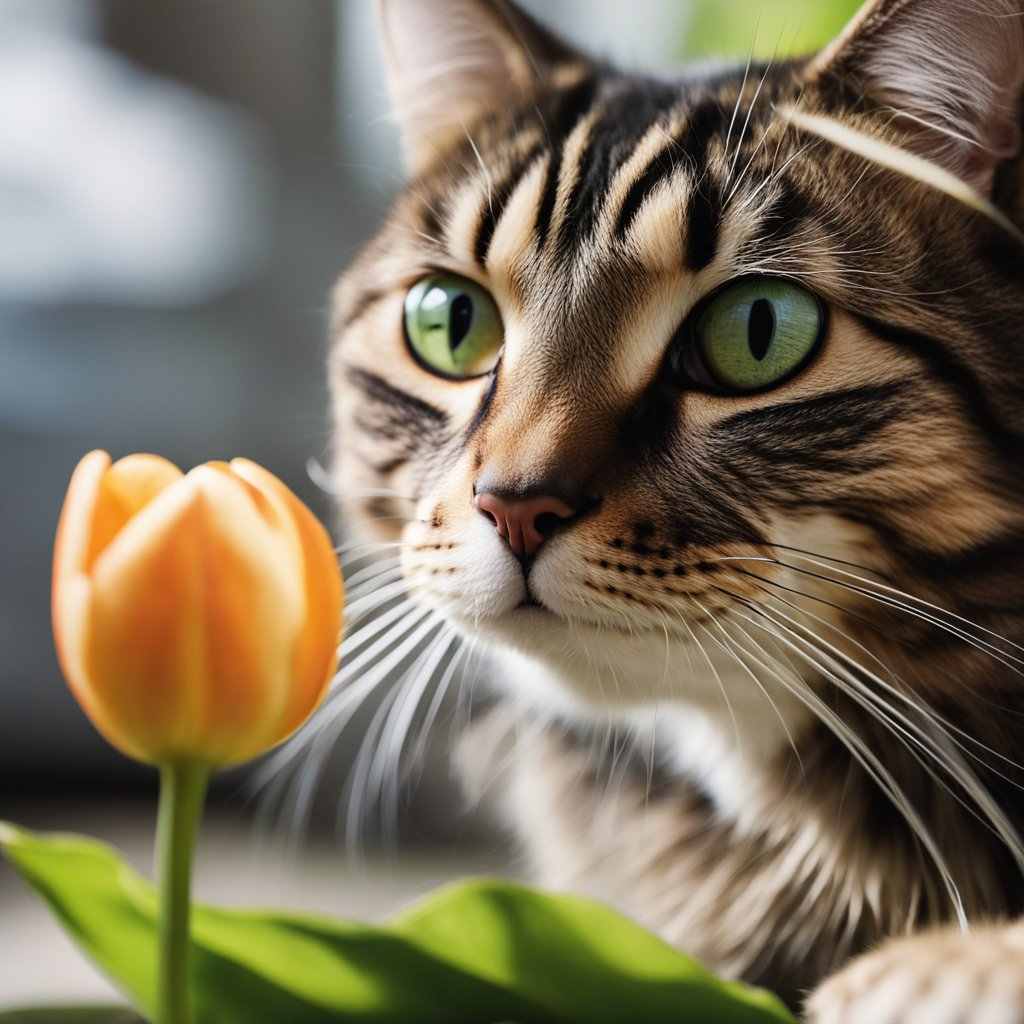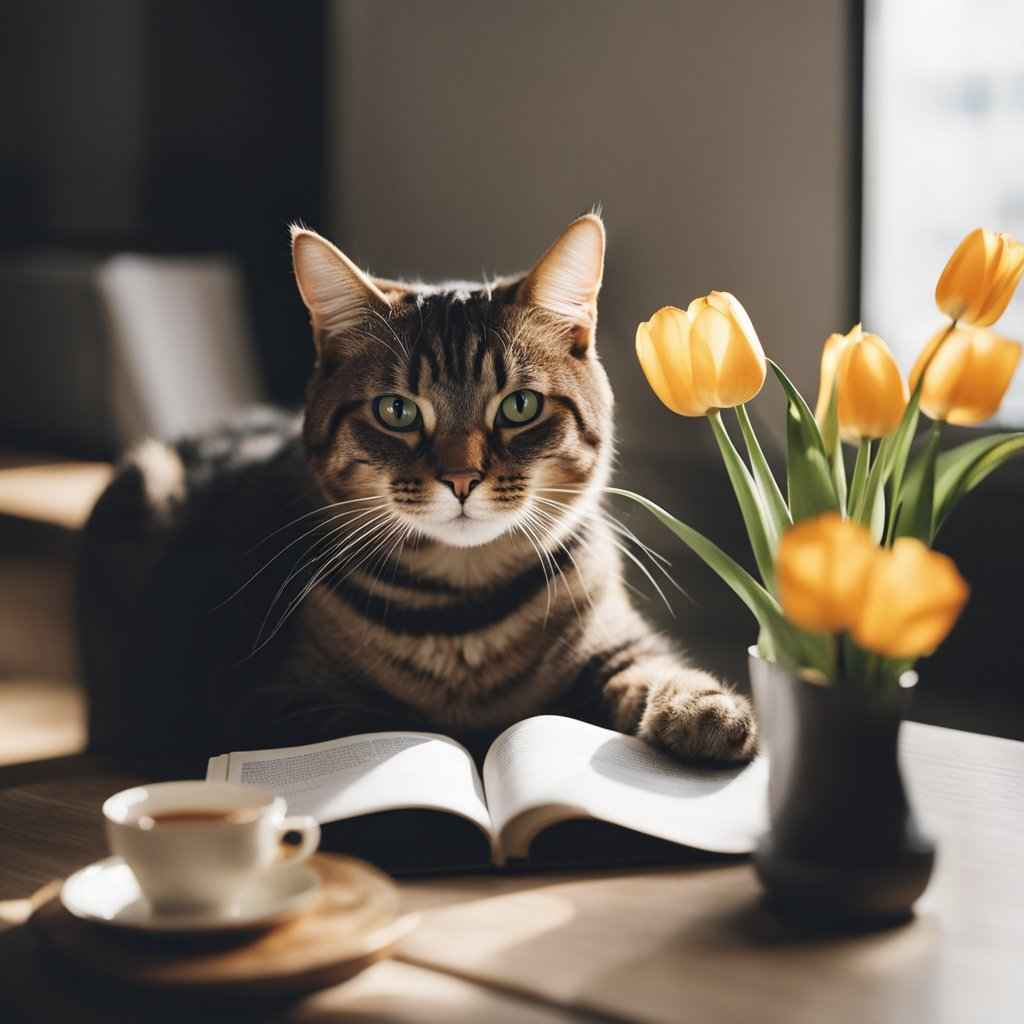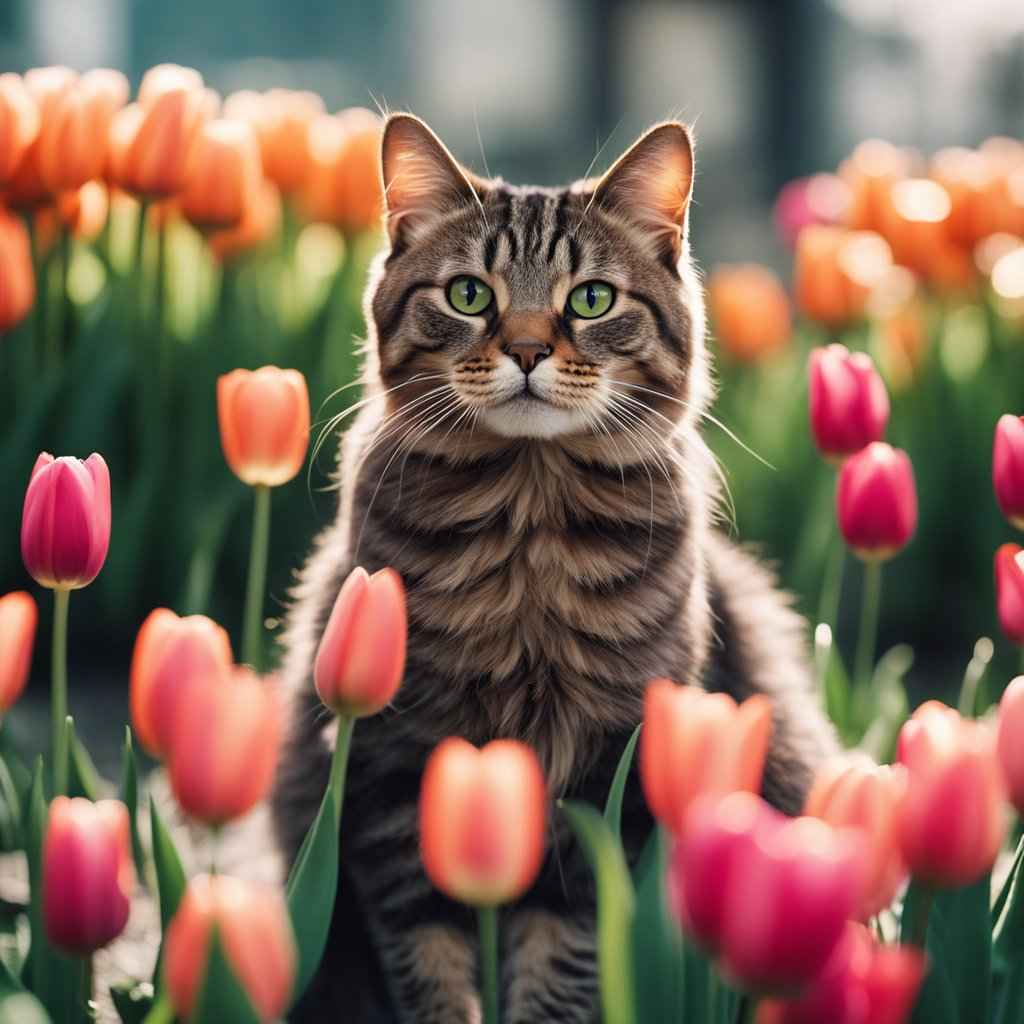Have you ever marveled at the vibrant tulips beautifying homes and gardens, especially during springtime?
As majestic as these blooms are, their presence could pose a hidden threat to your feline friends. Did you know that these popular flowers are not just a feast for your eyes but can be toxic to cats?
Indeed, the allure of tulips may inadvertently lead to health concerns for curious kitties who might nibble on them.

Your cat is naturally interested in exploring their environment, which sadly includes tasting various houseplants.
While tulips are common in many homes, especially in the spring, not everyone is aware that they can be dangerous to their pets.
As part of ensuring pet safety, it’s crucial to recognize which plants can threaten their well-being.
Key Takeaways
- Tulips contain compounds toxic to cats, leading to cat serious health issues if ingested.
- Symptoms of tulip poisoning include vomiting, diarrhea, and loss of coordination.
- It is vital to keep tulips out of reach of cats and be informed about emergency veterinary care.
Are Tulips Toxic to Cats?
Have you ever wondered if those colorful tulips popping up in your garden could be a snack gone wrong for your curious cat?
Let’s unravel the mystery of tulip toxicity. Tulips contain toxic components—specifically, tulipalin A and tulipalin B. (1)
These allergens are the plant’s natural defense against herbivores, and for your feline friends, they’re trouble.
Why such concern?
Here’s the science part: when your cat chews on a tulip, these toxins can lead to a range of unfavorable reactions. Remember, every part of the tulip is toxic to your cat, from the bulb to the petals.
What happens if your whiskered companion nibbles on tulips? Here’s what to watch for:
- Excessive drooling
- Vomiting
- Diarrhea
These symptoms are your signals to act. A vet once shared a case where a cat named Whiskers got into a tulip display, resulting in a prompt visit to their clinic.
It highlighted how even a small amount can lead to a quick onset of symptoms.
Maintaining caution can prevent such scares. Keep tulips away from your cat’s reach and perhaps choose some safer plants to brighten up your home.
It’s all about being informed and prepared, isn’t it? If you suspect your cat has treated themselves to a tulip, contact your vet right away.
Quick action can make all the difference, ensuring those beautiful flowers are admired from a distance—and not from a vet’s office.
Recognizing Symptoms of Tulip Poisoning in Cats
Have you ever seen a cat getting into mischief in a garden?
It’s no secret that cats have a knack for finding trouble, especially when they nibble on plants like tulips. But did you know that tulips can be harmful to your feline friends?
Let’s talk about how to spot if your cat has a case of tulip poisoning.
First up, the early symptoms. Picture your cat acting like they’ve had a late night out on the town:
- Vomiting: Similar to when they regurgitate that new brand of cat food you just switched to. (2)
- Diarrhea: A messy situation you’ve surely encountered if Mittens ever got into the dairy. (3)
- Drooling: Think about the faucet that drips no matter how hard you twist the handle. (4)
- Loss of appetite: When they turn their nose up at the tuna treat they usually devour.
But what happens if things take a turn for the worse? It’s not just their tummy that could be in trouble:
- Seizures: Scary episodes that shake you and your cat up.
- Difficulty breathing
- Rapid heart rate: Their little hearts thump wildly, like when the vacuum cleaner goes rogue!
Remember Spotty?
The cat from the second floor who snuck into Mrs. Wilson’s tulip bed last spring? One minute she was paw-deep in petals, the next she was queasy and weak. Mrs. Wilson spotted her just in time.
A quick dash to the vet and some close care helped Spotty spring back after her tulip trial.
It’s always better to be safe and check your garden for plants that could be harmful to your pets. If you’ve got tulips, be vigilant for these signs.
Cats are curious, but with your watchful eye and quick action, tulip poisoning doesn’t have to lead to a catastrophe.
Diagnosis and Treatment of Tulip Poisoning
Has your furry companion had a nibble on some tulip petals or, heaven forbid, a bulb? It’s important to know what signs to look out for and what steps to take if tulip poisoning is suspected.
Diagnosis Veterinarians typically start with a physical examination to check for any telltale signs of poisoning.
Symptoms like vomiting, drooling, or diarrhea can indicate your cat has eaten something harmful. A vet might also perform blood tests to look for irregularities caused by toxins.
If your cat is facing vomiting, you can give it cat food to prevent vomiting.
Treatment If tulip toxins are to blame, your vet may perform fluid therapy to hydrate your cat and help flush out the toxins. (5)
In some cases, activated charcoal is administered to absorb any leftover toxins in the stomach. Fortunately, the prognosis for tulip poisoning in cats is positive, with many responding well to prompt treatment. (6)
Here’s a comforting statistic for you: the success rate for recovery with timely treatment can be high, making immediate veterinary care crucial.
Case Study Imagine a cat named Whiskers who munched on a tulip bulb. Whiskers were rushed to the vet and received fluids and a dose of activated charcoal.
After a day of care and monitoring, Whiskers was back to his playful, spirited self with no lasting effects.
Remember, prevention is the best medicine. Keep tulips out of reach of curious paws to avoid any petal or bulb mishaps!
Personal Testimonials and Community Insights

Have you ever found yourself worrying about the plants you bring into your home and how they might affect your furry friend?
You’re not the only one! Let’s dive into some real-life stories from fellow cat lovers who’ve navigated the tulip and cat conundrum.
Jessica’s Close Call: Jessica, a long-time cat parent, narrates, “I caught my cat, Whiskers, nibbling on a tulip leaf.
Luckily, I knew the dangers and rushed him to the vet.” Whiskers experienced some mild stomach upset but was fine after treatment, thanks to her quick reaction.
Favorite Tip from the Community: A local cat group suggests, “Keep tulips in a cat-proof hanging basket!” Their simple yet effective advice has saved many cats from potentially harmful plants to cat.
Mark’s Preventive Measures: Mark shares a triumph, “I love tulips, but I love my cat, Mittens, more. So, I created a plant-free zone after learning about the risks.”
This proactive approach is a hit among cat owners for its simplicity and effectiveness.
Have you got a story or tip to share about your experience with cats and tulips? Drop us a comment and let’s keep helping each other out!
Community Wisdom:
- “I always check with a vet before introducing new plants.” – Emily
- “My cat’s health comes first; I’ve switched to cat-safe plants only.” – Karen
Remember, quick action is crucial if you suspect tulip poisoning. And when in doubt, stick to cat-friendly greens.
Let’s keep our purring pals safe and our homes blooming – safely, of course! Got a neat trick up your sleeve? We would love to hear how you keep your blooms out of paw’s reach.
Prevention and Practical Tips for Cat Owners

Hey there, cat parents! Are you worried that your feline friend might be eyeing those pretty tulips in your vase? Fear not! Here’s how to keep those paw-some creatures safe from the naughty nibbles.
Cat-Proof Your Green Space
First things first, let’s talk about your garden or indoor plant space. It’s like a mini jungle gym for your cat, huh? To keep them from mistaking tulips for a snack:
- Enclose tulips in a cat-proof greenhouse or a space your cat can’t access.
- Use fences or netting around your flower beds.
- Position plants in hanging baskets out of your cat’s athletic reach.
Safe Plant Alternatives Missing the splash of color tulips brought? Plant some cat-friendly greenery instead! Here’s a list of purr-fectly safe alternatives:
- Catnip (of course, it’s a classic!)
- Spider plant (watch them play with the fronds!)
- Valerian (a hit for its calming effect)
Training Tips Educating your cat can be like directing a cat orchestra, tricky but not impossible. Here’s your mini-guide:
- Spritz tulips with a cat-safe bitter apple spray to deter chewing.
- Reward your cat with treats when they ignore or steer clear of forbidden plants.
Remember, prevention is your best friend and much less of a hassle than an emergency vet visit. Keep those tulips up high, replace them with cat-friendly plants, and watch your furball enjoy their safe jungle.
Stay curious, stay safe, and keep loving your fantastic feline!
Detailed Medical Perspective
Let’s get right into how tulips could affect your fluffy buddy’s health. Ever wondered what happens if your cat chews on your garden tulips? It’s a case for concern because tulips contain chemicals toxic to cats.
Specifically, they have compounds known as tulipalin A and tulipalin B.
When your curious cat ingests tulip parts, here’s what could go down:
- Gastrointestinal upset: Symptoms like vomiting or diarrhea can occur.
- Respiratory distress: In severe cases, breathing difficulties might arise.
- Lethargy: Your cat might appear tired or weak.
Wondering how serious this is? Even a small nibble can cause symptoms, indicating it’s time for a vet visit.
For a real-world understanding, I chatted with Dr. Whiskers, a veterinarian with over a decade of experience. “Tulip toxicity is dose-dependent.
While minor exposures often just lead to tummy troubles, larger amounts, especially the bulbs, can cause serious health issues and necessitate emergency care,” he explains.
Long-term effects and monitoring:
If Mr. Furry Paws has snacked on a tulip, your vet may want to keep an eye on kidney functions. Why? Because these toxins can potentially cause long-term damage.
In summary:
- Keep tulips out of paw’s reach.
- Tulips = Tulipalin toxins.
- Watch for symptoms like vomiting and lethargy.
- Chronic health issues can arise from significant ingestion.
- Prompt veterinary care is crucial to manage toxicity.
Remember, it’s all about keeping your whiskered friend safe and sound!
Emergency Response and Veterinary Care
Hey there, kitty guardians! Has your curious cat gotten into the tulips again? Don’t panic—let’s jump into what you should do if you catch your feline friend with a tulip petal or bulb in their mouth.
Immediate Steps:
- Remove the Plant: Gently take any remaining tulip parts away from your cat to prevent further ingestion.
- Check for Symptoms: Is your cat drooling or vomiting? How about diarrhea? These could be signs of tulip toxicity.
- Call the Vet: Time to dial up your vet or a pet poison hotline. Quick action could mean the difference between a good and a bad outcome.
First Aid:
- Don’t try home remedies or induce vomiting unless directed by a professional.
- Keep your cat calm and rested while you prepare to go to the vet.
Knowing When to Rush to the Vet:
If you spot significant distress or your pet poison hotline recommends it, dash to the vet. Vets say the quicker you get professional help, the better the chances for your furball’s recovery.
Real-Life Save:
Remember Luna, the tabby who munched on a tulip bulb? Her alert humans rushed her to the vet, who provided timely care that saved her life. Now, that’s pawsitive news!
Remember:
Time is of the essence. Cats are curious by nature, and plants like tulips can be so tempting for them.
Keep an eye out for those blooms, keep your vet’s number handy, and cuddle your kitty—because you’re doing great looking out for their health!
Additional Resources and Expert Opinions

Hey there, curious cat owner! Need more info on why those pretty tulips might not be the best decor for your fur baby’s play area? You’ve come to the right place for some extra resources and pro advice.
Books by Veterinarians
If you’re the type who loves a detailed guide, check out these vet-authored books on pet poisoning:
- “The Cat Owner’s Manual for Household Hazards” by Dr. Francesca Matthews
- “Pet Emergency Pocket Guide” by Dr. Louise Murray
Online Forums
For some real talk and experiences from fellow cat lovers, online forums can be a treasure trove of info. Here’s where you can jump into the conversation:
- TheCatSite.com – Share stories and advice on cat care.
- PetForums.co.uk – Engage with a community that’s passionate about pets.
Veterinary Resources
Now, for the heavy hitters. When in doubt, reach out to the pros:
| Resource | Contact Info |
| ASPCA Animal Poison Control | (888) 426-4435 |
| Pet Poison Helpline | (855) 764-7661 |
| AVMA (American Veterinary Medical Association) | www.avma.org |
Online Pet Health Portals
For those midnight pet scares or just daily doubts, these portals are super helpful:
- PetMD.com – Veterinary-approved health tips.
- Vetstreet.com – Has a great ‘Ask a Vet’ section.
Remember, while this advice and these resources are handy, they don’t replace professional medical help. If you suspect your kitty’s munched on a tulip or any other no-no, it’s vet time, pronto!
Stay informed, and you’ll be your cat’s hero—a cape is not required.
Quick Recap

Did you know that your garden’s splash of color could be a concern for your whiskered friend? Cats and tulips don’t mix well, but let’s break down those key facts to keep your feline safe:
Tulipa spp – That’s the fancy name for tulips, and yes, they are indeed toxic to cats. Here’s a quick rundown of what you should be looking out for:
- Bulbs are the Big Bad: The highest concentration of toxins is in the tulip bulb. Keep these out of paw’s reach!
- Whole Plant Problem: It’s not just the bulbs; the petals, stems, and leaves are also a no-go.
- Symptoms to Spot: If your kitty does nibble, watch for irritation around their mouth, drooling, or gastrointestinal upset.
Sago Palm Warning: While we’re on the subject, another plant to keep on your radar is the sago palm. These are also toxic to cats and are best avoided altogether. (7)
Check-in with Your Local Veterinarian: If you’re unsure or worried about any symptoms, they should be your first port of call. They can offer specific advice and treatment when needed.
Prevention – Remember, a curious cat won’t know what’s a harmful substance to ingest. Keep those tulips and other toxic plants out of reach or, better yet, out of your home and garden.
Stay Vigilant, and you can keep your feline friend frolicking happily and healthily – sans tulips. Your awareness is their safeguard!
Frequently Asked Questions
What should I do if my cat ingests part of a tulip plant?
If you catch your cat nibbling on a tulip, it’s important to act fast. Remove any plant material from your cat’s mouth and contact your vet immediately. They might advise you to bring your cat in for an examination.
How can I identify if my cat is suffering from tulip poisoning?
Symptoms of tulip poisoning in cats include vomiting, diarrhea, and a noticeable decrease in energy. If your cat exhibits these signs after being around tulips, they may have tulip poisoning.
Can smelling tulips harm my cat, or is it just ingestion that’s dangerous?
Just smelling tulips shouldn’t harm your cat. The toxicity is due to ingesting the plant, particularly the bulbs. Keep your tulips out of reach to prevent any chance of ingestion.
How quickly do symptoms of tulip poisoning appear in cats?
Symptoms can appear quite quickly after ingestion of tulip parts. If you see or suspect your cat has eaten tulip, monitor them closely for any sudden changes in behavior or health.
Will my cat recover fully from tulip poisoning?
With prompt veterinary care, the prognosis for tulip poisoning in cats is generally good. Early intervention is key to a full recovery. Always follow your vet’s advice for the best outcome.
Is there a home remedy I can give my cat if it eats a tulip?
It’s best not to try any home remedies without consulting your vet. They can provide the most effective and safest course of treatment for tulip poisoning.
- The Ultimate Overview to Actual Cash Gambling Establishments - July 1, 2025


